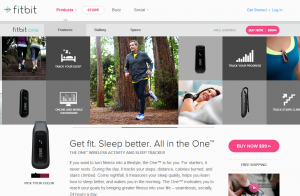Exercise has been touted as one of the best prevention tools for years. The research that emerges continues to reaffirm this belief. There is so much data that nobody can even dream of disputing that exercise can save your life.
The challenge is making exercise fun and enjoyable. Statistics themselves have failed to propel millions of couch potatoes off their comfortable cushions. Companies are responding at increasing rates to turn exercise itself into more of a game. This trend seems to be gaining traction in the US.
Capitalizing on this trend, Fitbit promises to improve not only your exercise but also your sleep, empowering you to take control of your overall health. One customer at a time, the company seeks to save lives and make the world a healthier place.
I never thought a pedometer could win my heart, but for me and Fitbit it was love at first sight—my first glimpse of the website, that is. The next time I hear someone say, “Your reputation precedes you,” I will remember my instant romance with Fitbit, a company that creates activity trackers so awesome they just might change the way the world exercises.

Fitbit: The Company + Its Products
Fitbit is the name of the San Fran startup that creates gadgets of the same name. Its various Fitbit products go beyond what traditional pedometers do. They track how many steps you’ve taken, how many calories you’ve burned, and the quality of your sleep.
Pretty cool idea, right? It gets better.
How Fitbit Gadgets Work
If you’ve used a traditional pedometer before, you know that all it does is count the number of steps you take. Pedometers have built-in mechanisms that track each time the sensors are moved up and down, as with stepping motions. Given the simplicity of the task, most pedometers aren’t that sophisticated, exciting or accurate.
It’s kind of cool to see how many steps you take each day. However, the biggest drawback of pedometers is that once the novelty of tracking my steps has worn off, the raw numbers cease to thrill me. For many people who face this dilemma, they start to feel like they will never get in shape, and thus they return to their couch potato lifestyles in utter despair.
By contrast, the entire mission of Fitbit isn’t just to give you a number, vainly hoping this will miraculously motivate you to change your sedentary lifestyle and sustain your lifelong devotion to working out. Indeed, the mission of Fitbit is to take this not one but ONE THOUSAND steps further—pun intended—to actually get you to change your life.
The Fitbit doesn’t just report numbers. It keeps track of your performance and designs routines around your personal needs. You can log into your account, see detailed charts of your exercise and sleep patterns, and take its advice to adjust your routines accordingly. It promises to help you improve your health on both sleep and exercise fronts.
That’s a pretty lofty brand promise. I’m fully trusting that it will help me sleep better, help me workout better, and improve my health accordingly.
An intriguing brand entices customers to learn more. A strong brand communicates a clear message, and a mighty brand inspires loyalty. It’s rare for a brand to take customers through this cycle quickly, but the best brands can sometimes achieve this even before customers have the chance to sample the products.
Such has been my experience so far with the Fitbit.
I just found out about the Fitbit and I’m ecstatic. I love the product and what it promises to achieve. The website is gorgeous. The branding is clear and concise. Their Google page rank of a solid 6 inspires confidence and the Alexa ranking demonstrates steady growth over the past year.
I’m in love—and I haven’t even tested their product yet! If I were on Shark Tank, I would throw money at FitBit CEO James Park right now. Sadly it’s too late for that sort of thing, even if I had the money to throw.
I’m waiting for my beautiful burgundy Fitbit to come in the mail. After I have the chance to play with it, I will write an in-depth review of the product. For now, let the record stand that I am lulled into loyalty by the website and philosophy behind its creation—before I’ve even tried the product out!
To Be Continued . . .